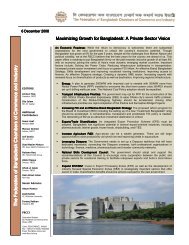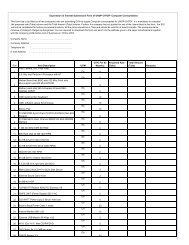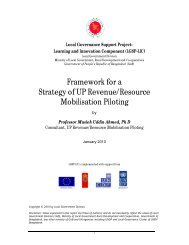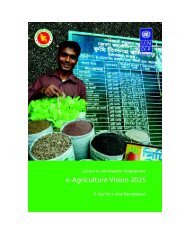The probable impacts of climate change on poverty - UNDP
The probable impacts of climate change on poverty - UNDP
The probable impacts of climate change on poverty - UNDP
Create successful ePaper yourself
Turn your PDF publications into a flip-book with our unique Google optimized e-Paper software.
producti<strong>on</strong> <str<strong>on</strong>g>of</str<strong>on</strong>g> particular fish species are expected due to c<strong>on</strong>tinued warming, with adverse effects projected for<br />
aquaculture and fisheries. <str<strong>on</strong>g>The</str<strong>on</strong>g> important challenge would be access to and distributi<strong>on</strong> <str<strong>on</strong>g>of</str<strong>on</strong>g> food.<br />
4.1.4 Coastal & Low Lying Areas<br />
Coastal systems and low-lying areas are projected to be exposed to increasing risks, including coastal erosi<strong>on</strong>,<br />
due to <str<strong>on</strong>g>climate</str<strong>on</strong>g> <str<strong>on</strong>g>change</str<strong>on</strong>g> and sea-level rise. Many milli<strong>on</strong> more people are projected to be flooded every year due<br />
to sea-level rise by the 2080s. Those densely-populated and low-lying areas where adaptive capacity is relatively<br />
low, and which already face other challenges such as tropical storms or local coastal subsidence, are especially at<br />
risk. <str<strong>on</strong>g>The</str<strong>on</strong>g> numbers affected will be largest in the mega-deltas <str<strong>on</strong>g>of</str<strong>on</strong>g> Asia and Africa while small islands are especially<br />
vulnerable. Adaptati<strong>on</strong> for coasts will be more challenging in developing countries than in developed countries,<br />
due to c<strong>on</strong>straints <strong>on</strong> adaptive capacity.<br />
4.1.5 Industry and Human Settlement<br />
Industry, settlement and society: costs and benefits <str<strong>on</strong>g>of</str<strong>on</strong>g> <str<strong>on</strong>g>climate</str<strong>on</strong>g> <str<strong>on</strong>g>change</str<strong>on</strong>g> for industry, settlement and society will<br />
vary widely by locati<strong>on</strong> and scale. In the aggregate, however, net effects will tend to be more negative the larger<br />
the <str<strong>on</strong>g>change</str<strong>on</strong>g> in <str<strong>on</strong>g>climate</str<strong>on</strong>g>. <str<strong>on</strong>g>The</str<strong>on</strong>g> most vulnerable industries, settlements and societies are generally those in coastal<br />
and river flood plains, those whose ec<strong>on</strong>omies are closely linked with <str<strong>on</strong>g>climate</str<strong>on</strong>g>-sensitive resources, and those in<br />
areas pr<strong>on</strong>e to extreme weather events, especially where rapid urbanisati<strong>on</strong> is occurring. Poor communities can<br />
be especially vulnerable, in particular those c<strong>on</strong>centrated in high-risk areas. <str<strong>on</strong>g>The</str<strong>on</strong>g>y tend to have more limited<br />
adaptive capacities, and are more dependent <strong>on</strong> <str<strong>on</strong>g>climate</str<strong>on</strong>g>-sensitive resources such as local water and food<br />
supplies.<br />
4.1.6 Health and Nutriti<strong>on</strong><br />
Projected <str<strong>on</strong>g>climate</str<strong>on</strong>g> <str<strong>on</strong>g>change</str<strong>on</strong>g>-related exposures are likely to affect the health status <str<strong>on</strong>g>of</str<strong>on</strong>g> milli<strong>on</strong>s <str<strong>on</strong>g>of</str<strong>on</strong>g> people, particularly<br />
those with low adaptive capacity, through increases in malnutriti<strong>on</strong> and c<strong>on</strong>sequent disorders, with implicati<strong>on</strong>s<br />
for child growth and development; increased deaths, disease and injury due to heat-waves, floods, storms, fires<br />
and droughts; the increased burden <str<strong>on</strong>g>of</str<strong>on</strong>g> diarrhoeal disease; the increased frequency <str<strong>on</strong>g>of</str<strong>on</strong>g> cardio-respiratory diseases<br />
due to higher c<strong>on</strong>centrati<strong>on</strong>s <str<strong>on</strong>g>of</str<strong>on</strong>g> ground-level oz<strong>on</strong>e related to <str<strong>on</strong>g>climate</str<strong>on</strong>g> <str<strong>on</strong>g>change</str<strong>on</strong>g>; and, the altered spatial<br />
distributi<strong>on</strong> <str<strong>on</strong>g>of</str<strong>on</strong>g> some infectious disease vectors.<br />
By 2020, between 75 milli<strong>on</strong> and 250 milli<strong>on</strong> people are projected to be exposed to increased water stress due to<br />
<str<strong>on</strong>g>climate</str<strong>on</strong>g> <str<strong>on</strong>g>change</str<strong>on</strong>g>. If coupled with increased demand, this will adversely affect livelihoods and exacerbate waterrelated<br />
problems. Agricultural producti<strong>on</strong>, including access to food, in many African countries and regi<strong>on</strong>s is<br />
projected to be severely compromised by <str<strong>on</strong>g>climate</str<strong>on</strong>g> variability and <str<strong>on</strong>g>change</str<strong>on</strong>g>. <str<strong>on</strong>g>The</str<strong>on</strong>g> area suitable for agriculture, the<br />
length <str<strong>on</strong>g>of</str<strong>on</strong>g> growing seas<strong>on</strong>s and yield potential, particularly al<strong>on</strong>g the margins <str<strong>on</strong>g>of</str<strong>on</strong>g> semi-arid and arid areas, are<br />
expected to decrease. This would further adversely affect food security and exacerbate malnutriti<strong>on</strong> in the<br />
c<strong>on</strong>tinent. In some countries, yields from rain-fed agriculture could be reduced by up to 50% by 2020.<br />
Towards the end <str<strong>on</strong>g>of</str<strong>on</strong>g> the 21st century, projected sea-level rise will affect low-lying coastal areas with large<br />
populati<strong>on</strong>s. <str<strong>on</strong>g>The</str<strong>on</strong>g> cost <str<strong>on</strong>g>of</str<strong>on</strong>g> adaptati<strong>on</strong> could amount to at least 5-10% <str<strong>on</strong>g>of</str<strong>on</strong>g> Gross Domestic Product (GDP). Glacier<br />
melt in the Himalayas is projected to increase flooding, and rock avalanches from destabilised slopes, and to<br />
affect water resources within the next two to three decades. This will be followed by decreased river flows as the<br />
glaciers recede.<br />
4.2 Climate Change - Regi<strong>on</strong>al C<strong>on</strong>text<br />
<str<strong>on</strong>g>The</str<strong>on</strong>g> Fourth Assessment Report <str<strong>on</strong>g>of</str<strong>on</strong>g> the Intergovernmental Panel <strong>on</strong> Climate Change (IPCC), for South Asia, predicts<br />
that m<strong>on</strong>so<strong>on</strong> rainfall will increase, resulting in higher flows during m<strong>on</strong>so<strong>on</strong> seas<strong>on</strong> in the river system. It has<br />
also predicted that sea level rise will be between 0.18 to 0.79 meters which will lead to salinity intrusi<strong>on</strong> and<br />
coastal flooding.<br />
Glacier melt in the Himalayas is projected to increase flooding, and rock avalanches from destabilised slopes, and<br />
to affect water resources within the next two to three decades. This will be followed by decreased river flows as<br />
20<br />
<str<strong>on</strong>g>The</str<strong>on</strong>g> Probable Impacts <str<strong>on</strong>g>of</str<strong>on</strong>g> Climate Change <strong>on</strong> Poverty and Ec<strong>on</strong>omic Growth and<br />
the Opti<strong>on</strong>s <str<strong>on</strong>g>of</str<strong>on</strong>g> Coping with adverse Effect <str<strong>on</strong>g>of</str<strong>on</strong>g> Climate Change in Bangladesh










